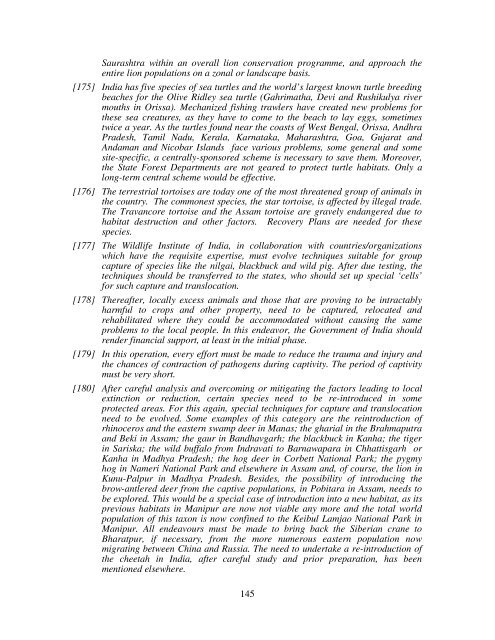Wildlife and Nature Conservation - Centre for Ecological Sciences
Wildlife and Nature Conservation - Centre for Ecological Sciences
Wildlife and Nature Conservation - Centre for Ecological Sciences
You also want an ePaper? Increase the reach of your titles
YUMPU automatically turns print PDFs into web optimized ePapers that Google loves.
Saurashtra within an overall lion conservation programme, <strong>and</strong> approach theentire lion populations on a zonal or l<strong>and</strong>scape basis.[175] India has five species of sea turtles <strong>and</strong> the world’s largest known turtle breedingbeaches <strong>for</strong> the Olive Ridley sea turtle (Gahrimatha, Devi <strong>and</strong> Rushikulya rivermouths in Orissa). Mechanized fishing trawlers have created new problems <strong>for</strong>these sea creatures, as they have to come to the beach to lay eggs, sometimestwice a year. As the turtles found near the coasts of West Bengal, Orissa, AndhraPradesh, Tamil Nadu, Kerala, Karnataka, Maharashtra, Goa, Gujarat <strong>and</strong>Andaman <strong>and</strong> Nicobar Isl<strong>and</strong>s face various problems, some general <strong>and</strong> somesite-specific, a centrally-sponsored scheme is necessary to save them. Moreover,the State Forest Departments are not geared to protect turtle habitats. Only along-term central scheme would be effective.[176] The terrestrial tortoises are today one of the most threatened group of animals inthe country. The commonest species, the star tortoise, is affected by illegal trade.The Travancore tortoise <strong>and</strong> the Assam tortoise are gravely endangered due tohabitat destruction <strong>and</strong> other factors. Recovery Plans are needed <strong>for</strong> thesespecies.[177] The <strong>Wildlife</strong> Institute of India, in collaboration with countries/organizationswhich have the requisite expertise, must evolve techniques suitable <strong>for</strong> groupcapture of species like the nilgai, blackbuck <strong>and</strong> wild pig. After due testing, thetechniques should be transferred to the states, who should set up special ‘cells’<strong>for</strong> such capture <strong>and</strong> translocation.[178] Thereafter, locally excess animals <strong>and</strong> those that are proving to be intractablyharmful to crops <strong>and</strong> other property, need to be captured, relocated <strong>and</strong>rehabilitated where they could be accommodated without causing the sameproblems to the local people. In this endeavor, the Government of India shouldrender financial support, at least in the initial phase.[179] In this operation, every ef<strong>for</strong>t must be made to reduce the trauma <strong>and</strong> injury <strong>and</strong>the chances of contraction of pathogens during captivity. The period of captivitymust be very short.[180] After careful analysis <strong>and</strong> overcoming or mitigating the factors leading to localextinction or reduction, certain species need to be re-introduced in someprotected areas. For this again, special techniques <strong>for</strong> capture <strong>and</strong> translocationneed to be evolved. Some examples of this category are the reintroduction ofrhinoceros <strong>and</strong> the eastern swamp deer in Manas; the gharial in the Brahmaputra<strong>and</strong> Beki in Assam; the gaur in B<strong>and</strong>havgarh; the blackbuck in Kanha; the tigerin Sariska; the wild buffalo from Indravati to Barnawapara in Chhattisgarh orKanha in Madhya Pradesh; the hog deer in Corbett National Park; the pygmyhog in Nameri National Park <strong>and</strong> elsewhere in Assam <strong>and</strong>, of course, the lion inKunu-Palpur in Madhya Pradesh. Besides, the possibility of introducing thebrow-antlered deer from the captive populations, in Pobitara in Assam, needs tobe explored. This would be a special case of introduction into a new habitat, as itsprevious habitats in Manipur are now not viable any more <strong>and</strong> the total worldpopulation of this taxon is now confined to the Keibul Lamjao National Park inManipur. All endeavours must be made to bring back the Siberian crane toBharatpur, if necessary, from the more numerous eastern population nowmigrating between China <strong>and</strong> Russia. The need to undertake a re-introduction ofthe cheetah in India, after careful study <strong>and</strong> prior preparation, has beenmentioned elsewhere.145
















